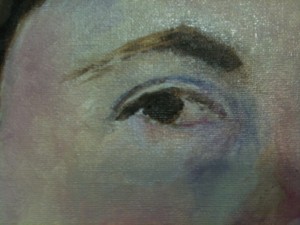On Art and Ignorance III
|
A thing has occurred to me very late at night, regarding the post by Jack of Kent on Art and Exhibitions I should mention at this point that I agree with large lumps of what Mr Caent, really @davidallengreen says. In this particular case, I am going to go out on a limb and say I disagree about a certain sort of person who goes to art galleries.
Imagine you are at the zoo. This is not really dissimilar. You look into the cages, you read the material, and perhaps you look for the hidden animals. You are probably there with company. The company may be small children, guests to town, adult family, or friends of any sort. The children who find it new and exciting gawp directly at the animals. Tigers are popular. People who have seen tigers before read the posters and think about how much lunch will cost. A proportion of visitors will be experts on animals already. The others may not care much about the animals, because they are there for a day out, but the fact that they are there to see the animals means that those animals will be seen, damnit. The question is what these people take away. In the case of London Zoo, I have ridden on a camel. Those rides are not allowed any more, I think, but nothing can take away the fact that I have ridden on one. Something can take away future rides, and that is the law on working animals, which takes into account possible cruelty and danger issues on either side. I here advance my theory; art galleries are like zoos. Not so much as Prime Minister’s Question Time is, but with the same aspects. You go to see a spectacle. Perhaps, if it is your first time, it will be hugely exciting. Perhaps it will be just a walk around a woodchip path while the Little Nipper eats too much ice-cream and is sick from the top floor of the giraffe house. However, there is an expectation that your party will be better off for going. The Gorilla enclosure at London Zoo is 6000 square meters. The original cages were much smaller, and devoid of interest for their inhabitants. What is known as the Raven Cage was home to two vultures. Returning the analogy to art galleries, I find a couple of questions. What is the analogue of the zoo, in gallery worlds, and what is the continuum of progession. Jack of Kent kindly answered the first one in his first three words. He is talking about ‘every major art exhibition’. So am I, fortunately. We can continue. The next question is one that is not really answerable. At what stage do we say that we have the best practice in art captioning? There is an attempt to present information that adds to the experience for the interested, but there is also an assumption that everyone is interested in the information, and has time to stop and look at the paintings. The man on the Clapham Omnibus has no time free in the week. He buys his timed ticket at the weekend, and he is not expected to have any real knowledge of what he is seeing. There are very few artists who know the anatomy of a tiger, even if they can draw the outside. The issue of what to mention about a particular work when time will be limited is a big one. Curators have authority in this world, and people are (see my previous posts) nervous of disagreeing. However, I have to disagree with the notion that the ignorant man should not be allowed his ticket to see. No matter what he sees, he has paid his money, taken his choice, and taken his turn. What he takes from it might only be the satisfaction of having been to see the Leonardo. It is not up to me, and not up to anyone, to judge him for that anywhere but our own hearts. If someone goes to the zoo and does not look at the tigers, it is no skin off my nose. If someone goes to the Fitzwilliam and ignores the Vermeers, I will be very surprised, but I will not judge them. If they do not know how to look at art, remember that nobody is an expert at everything. I know how to look at traditional art painted in the Western traditions. If I were in the Middle East, I would be lost for any form of understanding. I would want to know the context of paintings, because that is tremendously important to me. You cannot look at the work of Artemisia Gentileschi in the same way once you know her life story. It does annoy me when people glance at a painting and move on, but that irritation occurs mainly when people do it to mine. I cannot say I feel it over the work of others. There is no need to help other people to feel one’s own personal asthetic at the expense of theirs. Ten thousand boring English lessons have been made of that attempt. Yes, the public should be more educated about more things; this particular example should be altered at the curation end. I have sympathy with Jack of Kent’s wishes, but not with his proscriptions. It would be nice if everyone made up their own minds about art. It would be nice if I won the lottery, but the odds are long enough that I don’t even buy tickets. If I won the lottery, I have no idea at all which artworks I would buy, but I’d have more wall space for them. |
